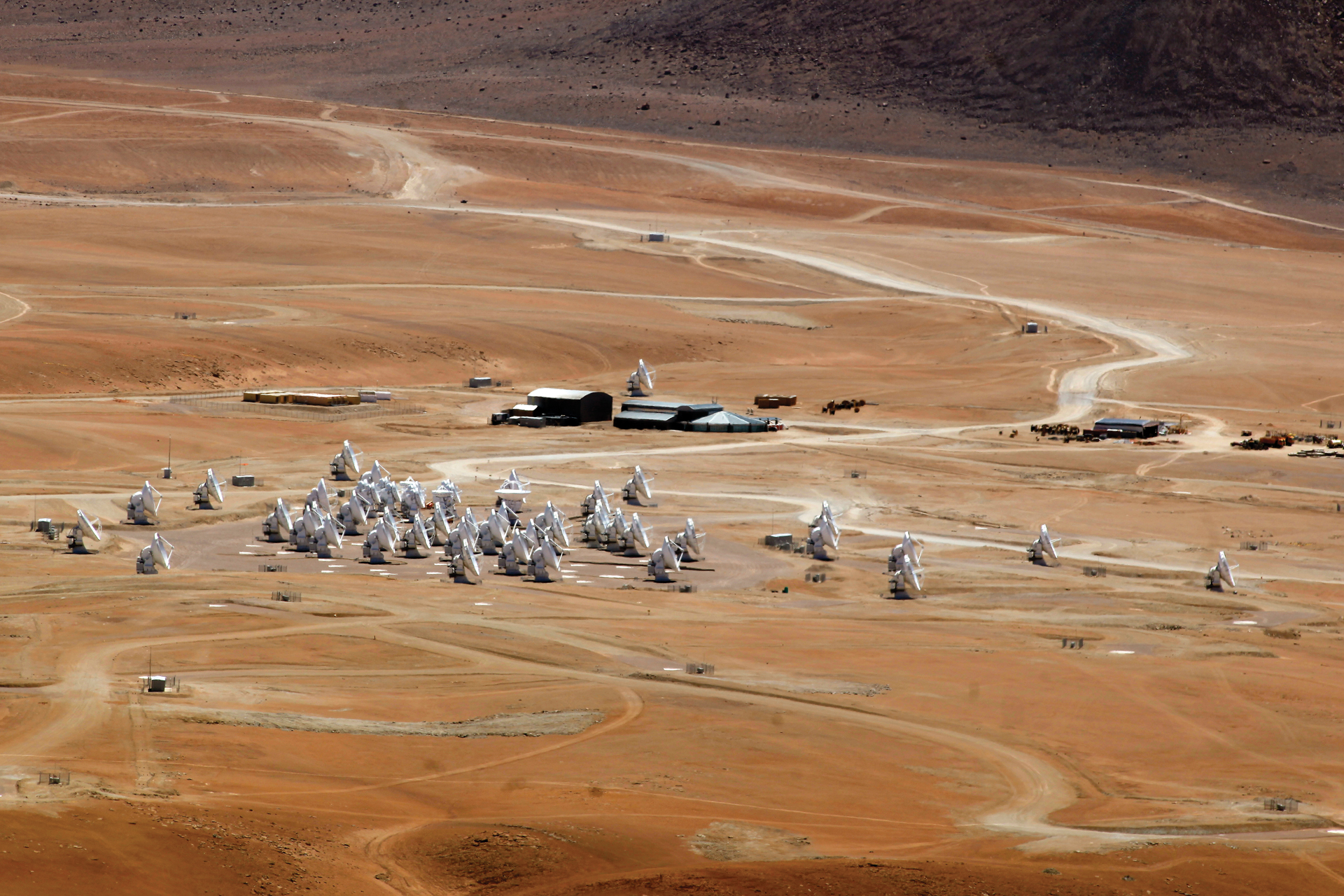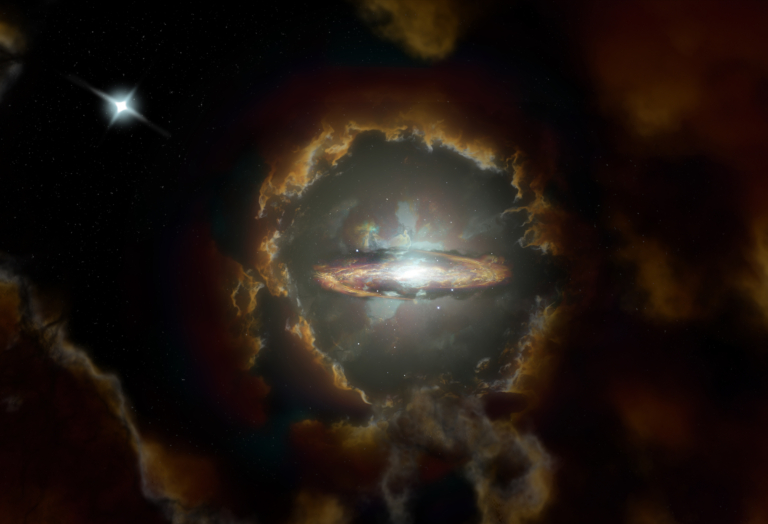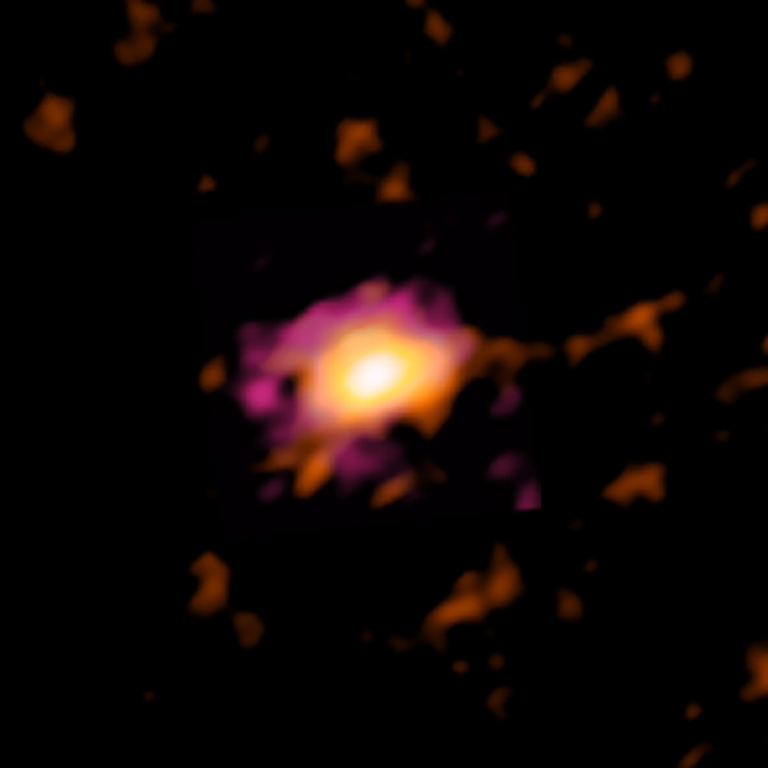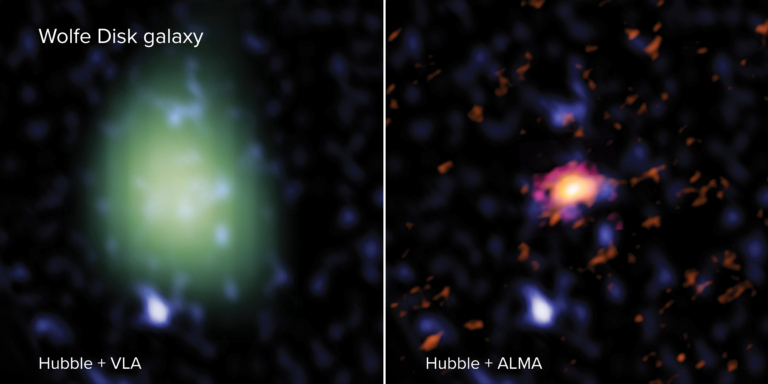Researchers have identified an exceptionally unusual cosmic object known as a Long Period Radio Transient (LPT), named CHIME J1634+44.
Recent News
Astronomers Discover Massive Molecular Cloud Hidden in Milky Way
In a new study published in the Astrophysical Journal, researchers using the U.S. National Science Foundation Green Bank Telescope (NSF GBT) have peered into a molecular cloud known as M4.7-0.8, nicknamed the Midpoint cloud. Their observations have revealed a dynamic region bustling with activity, including potential sites of new star formation.
Galactic Mystery: How “Ice Cubes” Survive in the Milky Way’s Blazing Bubbles
A team of astronomers has made a surprising discovery using the U.S. National Science Foundation Green Bank Telescope (NSF GBT): eleven fast-moving clouds of cold, neutral hydrogen gas—akin to “ice cubes”—surviving deep inside the Fermi Bubbles.
ALMA Discovers Massive Rotating Disk in Early Universe
of a massive rotating disk galaxy, seen when the universe was only ten percent of its current age, challenges the traditional models of galaxy formation. This research appears on 20 May 2020 in the journal Nature.

Galaxy DLA0817g, nicknamed the Wolfe Disk after the late astronomer Arthur M. Wolfe, is the most distant rotating disk galaxy ever observed. The unparalleled power of ALMA made it possible to see this galaxy spinning at 170 miles (272 kilometers) per second, similar to our Milky Way.
“While previous studies hinted at the existence of these early rotating gas-rich disk galaxies, thanks to ALMA we now have unambiguous evidence that they occur as early as 1.5 billion years after the Big Bang,” said lead author Marcel Neeleman of the Max Planck Institute for Astronomy in Heidelberg, Germany.
How did the Wolfe Disk form?
The discovery of the Wolfe Disk provides a challenge for many galaxy formation simulations, which predict that massive galaxies at this point in the evolution of the cosmos grew through many mergers of smaller galaxies and hot clumps of gas.
“Most galaxies that we find early in the universe look like train wrecks because they underwent consistent and often ‘violent’ merging,” explained Neeleman. “These hot mergers make it difficult to form well-ordered, cold rotating disks like we observe in our present universe.”
In most galaxy formation scenarios, galaxies only start to show a well-formed disk around 6 billion years after the Big Bang. The fact that the astronomers found such a disk galaxy when the universe was only ten percent of its current age, indicates that other growth processes must have dominated.
“We think the Wolfe Disk has grown primarily through the steady accretion of cold gas,” said J. Xavier Prochaska, of the University of California, Santa Cruz and coauthor of the paper. “Still, one of the questions that remains is how to assemble such a large gas mass while maintaining a relatively stable, rotating disk.”
Star formation
The team also used the National Science Foundation’s Karl G. Jansky Very Large Array (VLA) and the NASA/ESA Hubble Space Telescope to learn more about star formation in the Wolfe Disk. In radio wavelengths, ALMA looked at the galaxy’s movements and mass of atomic gas and dust while the VLA measured the amount of molecular mass – the fuel for star formation. In UV-light, Hubble observed massive stars. “The star formation rate in the Wolfe Disk is at least ten times higher than in our own galaxy,” explained Prochaska. “It must be one of the most productive disk galaxies in the early universe.”
A ‘normal’ galaxy
The Wolfe Disk was first discovered by ALMA in 2017. Neeleman and his team found the galaxy when they examined the light from a more distant quasar. The light from the quasar was absorbed as it passed through a massive reservoir of hydrogen gas surrounding the galaxy – which is how it revealed itself. Rather than looking for direct light from extremely bright, but more rare galaxies, astronomers used this ‘absorption’ method to find fainter, and more ‘normal’ galaxies in the early universe.
“The fact that we found the Wolfe Disk using this method, tells us that it belongs to the normal population of galaxies present at early times,” said Neeleman. “When our newest observations with ALMA surprisingly showed that it is rotating, we realized that early rotating disk galaxies are not as rare as we thought and that there should be a lot more of them out there.”
“This observation epitomizes how our understanding of the universe is enhanced with the advanced sensitivity that ALMA brings to radio astronomy,” said Joe Pesce, astronomy program director at the National Science Foundation, which funds the telescope. “ALMA allows us to make new, unexpected findings with almost every observation.”
The National Radio Astronomy Observatory is a facility of the National Science Foundation, operated under cooperative agreement by Associated Universities, Inc.
# # #
Media contact:
Iris Nijman
News and Public Information Manager
National Radio Astronomy Observatory (NRAO)
[email protected]
+1 (434) 249-3423
This research was presented in a paper titled “A Cold, Massive, Rotating Disk 1.5 Billion Years after the
Big Bang,” by Marcel Neeleman & J. Xavier Prochaska, et al., appearing in the journal Nature. DOI: 10.1038/s41586-020-2276-y
The Atacama Large Millimeter/submillimeter Array (ALMA), an international astronomy facility, is a partnership of the European Organisation for Astronomical Research in the Southern Hemisphere (ESO), the U.S. National Science Foundation (NSF) and the National Institutes of Natural Sciences (NINS) of Japan in cooperation with the Republic of Chile. ALMA is funded by ESO on behalf of its Member States, by NSF in cooperation with the National Research Council of Canada (NRC) and the Ministry of Science and Technology (MOST) and by NINS in cooperation with the Academia Sinica (AS) in Taiwan and the Korea Astronomy and Space Science Institute (KASI).
ALMA construction and operations are led by ESO on behalf of its Member States; by the National Radio Astronomy Observatory (NRAO), managed by Associated Universities, Inc. (AUI), on behalf of North America; and by the National Astronomical Observatory of Japan (NAOJ) on behalf of East Asia. The Joint ALMA Observatory (JAO) provides the unified leadership and management of the construction, commissioning and operation of ALMA.


Video Press Release

Recent News
Space’s Spinning Enigma: A ‘Unicorn’ Object Defies Astrophysics
Researchers have identified an exceptionally unusual cosmic object known as a Long Period Radio Transient (LPT), named CHIME J1634+44.
Astronomers Discover Massive Molecular Cloud Hidden in Milky Way
In a new study published in the Astrophysical Journal, researchers using the U.S. National Science Foundation Green Bank Telescope (NSF GBT) have peered into a molecular cloud known as M4.7-0.8, nicknamed the Midpoint cloud. Their observations have revealed a dynamic region bustling with activity, including potential sites of new star formation.
Galactic Mystery: How “Ice Cubes” Survive in the Milky Way’s Blazing Bubbles
A team of astronomers has made a surprising discovery using the U.S. National Science Foundation Green Bank Telescope (NSF GBT): eleven fast-moving clouds of cold, neutral hydrogen gas—akin to “ice cubes”—surviving deep inside the Fermi Bubbles.
